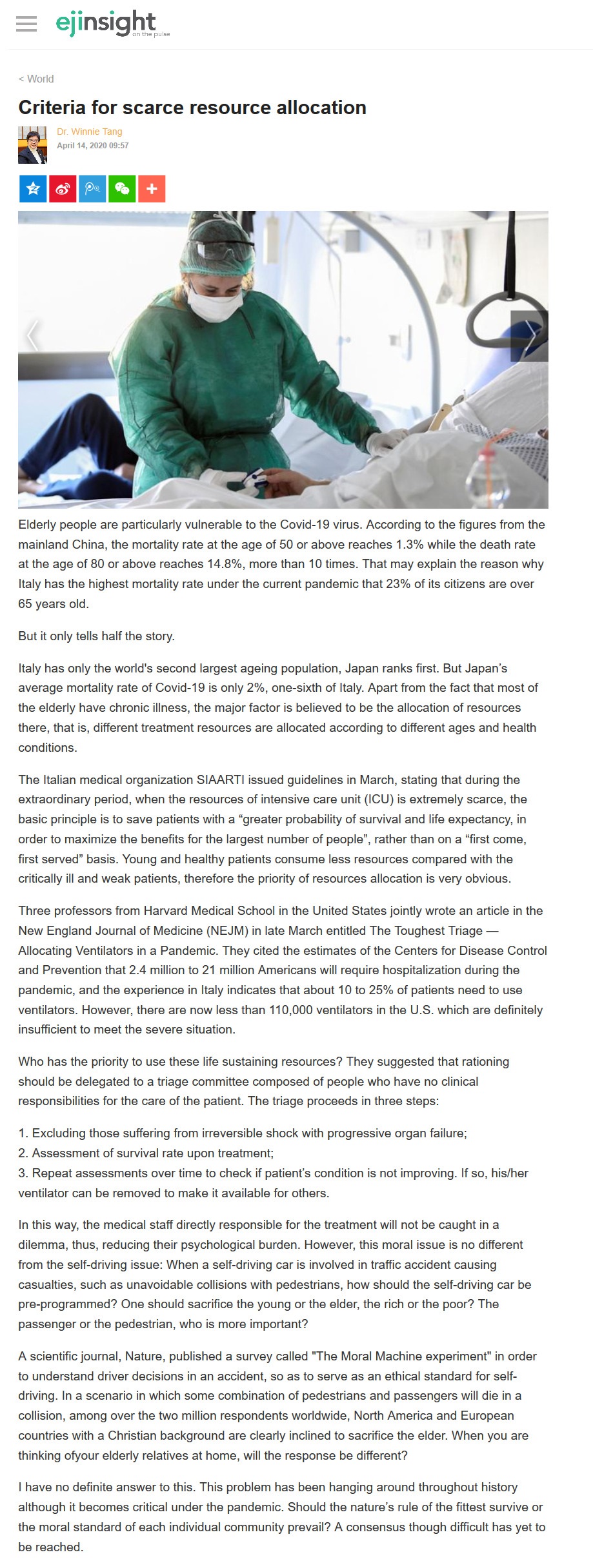網上版請按此

Criteria for scarce resource allocation
Elderly people are particularly vulnerable to the Covid-19 virus. According to the figures from the mainland China, the mortality rate at the age of 50 or above reaches 1.3% while the death rate at the age of 80 or above reaches 14.8%, more than 10 times. That may explain the reason why Italy has the highest mortality rate under the current pandemic that 23% of its citizens are over 65 years old.
But it only tells half the story.
Italy has only the world's second largest ageing population, Japan ranks first. But Japan's average mortality rate of Covid-19 is only 2%, one-sixth of Italy. Apart from the fact that most of the elderly have chronic illness, the major factor is believed to be the allocation of resources there, that is, different treatment resources are allocated according to different ages and health conditions.
The Italian medical organization SIAARTI issued guidelines in March, stating that during the extraordinary period, when the resources of intensive care unit (ICU) is extremely scarce, the basic principle is to save patients with a "greater probability of survival and life expectancy, in order to maximize the benefits for the largest number of people", rather than on a "first come, first served" basis. Young and healthy patients consume less resources compared with the critically ill and weak patients, therefore the priority of resources allocation is very obvious.
Three professors from Harvard Medical School in the United States jointly wrote an article in the New England Journal of Medicine (NEJM) in late March entitled The Toughest Triage — Allocating Ventilators in a Pandemic. They cited the estimates of the Centers for Disease Control and Prevention that 2.4 million to 21 million Americans will require hospitalization during the pandemic, and the experience in Italy indicates that about 10 to 25% of patients need to use ventilators. However, there are now less than 110,000 ventilators in the U.S. which are definitely insufficient to meet the severe situation.
Who has the priority to use these life sustaining resources? They suggested that rationing should be delegated to a triage committee composed of people who have no clinical responsibilities for the care of the patient. The triage proceeds in three steps:
1. Excluding those suffering from irreversible shock with progressive organ failure;
2. Assessment of survival rate upon treatment;
3. Repeat assessments over time to check if patient's condition is not improving. If so, his/her ventilator can be removed to make it available for others.
In this way, the medical staff directly responsible for the treatment will not be caught in a dilemma, thus, reducing their psychological burden. However, this moral issue is no different from the self-driving issue: When a self-driving car is involved in traffic accident causing casualties, such as unavoidable collisions with pedestrians, how should the self-driving car be pre-programmed? One should sacrifice the young or the elder, the rich or the poor? The passenger or the pedestrian, who is more important?
A scientific journal, Nature, published a survey called "The Moral Machine experiment" in order to understand driver decisions in an accident, so as to serve as an ethical standard for self-driving. In a scenario in which some combination of pedestrians and passengers will die in a collision, among over the two million respondents worldwide, North America and European countries with a Christian background are clearly inclined to sacrifice the elder. When you are thinking ofyour elderly relatives at home, will the response be different?
I have no definite answer to this. This problem has been hanging around throughout history although it becomes critical under the pandemic. Should the nature's rule of the fittest survive or the moral standard of each individual community prevail? A consensus though difficult has yet to be reached.
Dr. Winnie Tang
Adjunct Professor, Department of Computer Science, Faculty of Engineering and Faculty of Architecture, The University of Hong Kong